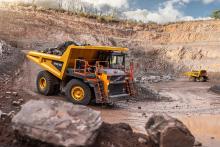
The new E-generation Volvo R60 rigid hauler is suitable for heavy-duty quarrying and mining. Built for markets with tier 2-compliant engines and based on the R100E model, the R60 has a higher payload than the D-generation model it replaces, along with a durable design and new comfort and safety-enhancing features – which Volvo CE says enables it to move more for less with every cycle.
Drew Watson, global product manager for the Volvo R60 at Volvo CE, says: “The Volvo R60 offers a 55-tonne payload and body volume of 36m3, enabled by a V-shaped body ensuring optimum load retention and minimal material carry-back.
“The rigid hauler is a perfect match for a 90-tonne excavator and meets the industry standard of 10/10/20 where it can take 10% overload for 10% of the time but should not exceed 20%. To help operators haul the optimum amount of material, an optional On-Board Weighing system provides real-time payload insight to the hauler operator via the on-board display, and can predict the 10/10/20 payload.”
Contributing to speedy cycle times, the drivetrain combines high torque capability and high drive axle multiplication to deliver the traction force needed to take on the steepest site gradients.
Volvo says the R60 is also fuel efficient. Thanks to Volvo Dynamic Shift Control, gear selection automatically adapts to varying conditions, whilst ECO mode enables the hauler to default to the most efficient gear shifting schedule. In addition, auto engine-idle shut-down eliminates unnecessary fuel consumption and engine wear.
The rigid hauler is available with the Volvo CareTrack telematics system to enable remote machine monitoring and help boost efficiency even further. What’s more, customers can gain recommendations on the optimum fleet configuration and site set-up from their Volvo dealer, with the support of Volvo Site Simulation.
Designed to deliver high uptime and low operating costs, the R60 is built to last with a 60,000-hour life frame and a list of features that contribute to long-lasting performance and component life, including: a low centre of gravity and balanced weight distribution to provide rock-solid stability and spread the impact of loads and stresses across the machine; a high-strength, flexible chassis and responsive MacPherson strut with lower wishbone connection to absorb shocks and vibrations and improve the operator ride; a V-shaped body, manufactured from high impact and high abrasion resistant steel, with minimal number of panels and welds; and neutral coast inhibitor and engine overspeed protection to further minimise wear.
Servicing of the R60 is required every 500 hours and can be completed swiftly thanks to a straightforward machine design that includes grouped maintenance points located within easy reach either from the ground or the service platform, as well as common-sized bearings throughout.
On-board diagnostics provide insights into system pressures and temperatures, and fault reporting to facilitate and speed-up troubleshooting.
Volvo CE says the R60 is built with operator comfort and safety top of mind. Operators can enter the cab from both sides using anti-slip steps and walkways. The cab is now pressurized, Roll/Fall-OverProtective Structure-certified (ROPS/FOPS) and features a left-positioned operator station to aid safe passing. Volvo Smart View is an added option to improve visibility even further with a 360° birds-eye view of the work zone.
Ergonomically positioned displays, responsive fingertip controls and low-effort steering combine to make operation effortless. The adjustable air-suspended seat and a Bluetooth-enabled audio system add to operator comfort.
The Volvo R60 is equipped with two retardation systems to keep a steady speed and facilitate machine navigation when going downhill, reducing the need for operator input. When manually selected, the transmission retarder slows the drivetrain to limit wheel lock-up, particularly useful on steep declines or in wet conditions. The modulating braking retarder can be automatically activated when the operator’s foot is off the accelerator to maintain a gear selected constant engine speed. What’s more, fail-safe braking and secondary steering systems add to jobsite safety.









